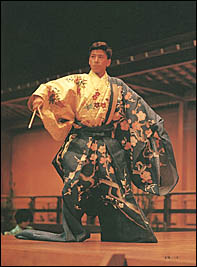 |
 |
 |
 |
 |
 |
|||||
 |
 |
 |
 |
|
MASTER COMIC: Young Leader of Traditional Theater Becomes Media Star February 1, 2000
At the beginning of September 1999, amid the lingering summer heat, 120 students and over 100 members of the general public gathered at Sanyo Gakuen University in Okayama Prefecture. Wearing white tabi (traditional Japanese socks with a split big toe to accommodate a thong sandal) and holding fans, the 220 participants performed a kouta (short noh song) and a dance under the guidance of a visiting professor, who then delivered a lecture on the day's theme, Japanese performance art theory. The lecturer was Motoya Izumi, age 25, the twentieth head master of the Izumi school of kyogen comic drama. (Kyogen pieces are traditionally performed as an interlude between separate noh plays.) "I don't want them to just acquire knowledge," Izumi says. "I want them to be able to experience for themselves the appeal of kyogen." The course, which includes both lectures and instruction in performance, has been more successful than expected. Izumi chose to focus his lectures on his real life experiences as a performing artist, and he seems to have struck a chord in many students' hearts. A Fresh Wind Now, as the head of a large school with a venerable tradition, he leads a very active life. In addition to giving over 250 kyogen performances a year, he also appears in Western-style plays, movies, TV dramas, and commercials. In this manner, Izumi is using a full range of modern expressive forms to keep alive a traditional art form. The activities of young kyogen performers like Izumi have sparked a new kyogen craze and are drawing a whole new group of fans to noh theaters. Timeless Humor Kyogen revolves around familiar characters who speak in the everyday language of their time. Over the past 600 years, it seems, the things that make people laugh have not changed all that much: Kyogen can be readily understood and thoroughly enjoyed by modern audiences. "Kyogen practice is a lot more fun than I expected," said a university student who took one of Izumi's courses. "I'm going to stick with the course till the end, and not miss a single day." Both kyogen and Izumi seem to be attracting a lot of new fans.
|


